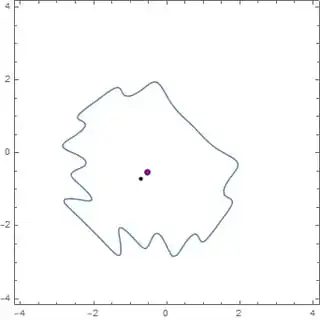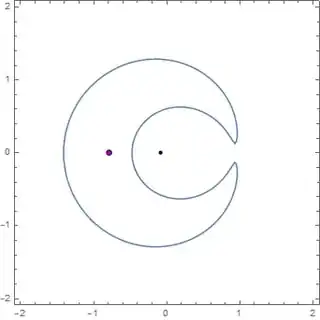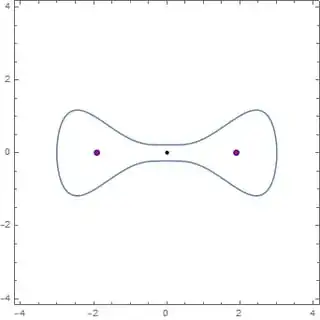I am a first-year undergraduate student. I came up with a kind of center property which I cannot find in articles online. I found the center on my own but needed help of mathematicians (@Rahul) on this site.
Currently I'm unsure whether it applies for non-star or open curves. For now, I'm limiting the scope of the definition.
Edit: The function $\overline{r}(x,y)$ may have more than one maximum. Another possibility is to take the average of the maximums. Hence the following is not a center but a property.
However, I would like to know of other possible centers.
Suppose the curve is star-shaped with respect to
this centerpoint(s) $\mathbf{p}$ so that any ray emanating from $\mathbf p$ meets the curve exactly once, at say point $\mathbf q$. Then $r = \|\mathbf q - \mathbf p\|$, $\theta$ is the angle between $\mathbf q-\mathbf p$ and the $x$-axis, $\overline{r}(x,y)$ is the average radius $$\overline{r}(x,y)=\frac1{2\pi}\oint_{\mathbf q\in\mathcal C}\|\mathbf q-\mathbf p\|\,\mathrm d\theta.$$and $\mathbf{p}$
maximizeis the average of points maximizingare the points maximizing $\overline{r}$.(Conveniently, this integral can also be computed for non-star-shaped curves; for a ray that meets the curve multiple times, it amounts to taking the total length of all segments that lie in the interior of the curve.)
Note that "this center property" is not the centroid. This can be shown in Mathematica (thanks to @Rahul)
The center is computed using discretization, Euclidean Distance and Sums.
curve = DiscretizeRegion[
ImplicitRegion[
S1[x, y] == 1, {{x, -3, 3}, {y, -4, 4}}], {{-3, 3}, {-4, 4}},
AccuracyGoal -> 8]
q = MeshCoordinates[curve];
edges = First /@ MeshCells[curve, 1];
signedAngle[a_, b_] := Arg[(Complex @@ a)/(Complex @@ b)]
avgRadius[p_] :=
1/(2 \[Pi]) Abs[Sum[Module[{q1, q2, r, d\[Theta]}, q1 = q[[First@e]];
q2 = q[[Last@e]];
r = EuclideanDistance[p, (q1 + q2)/2];(*midpoint approximation*)
d\[Theta] = signedAngle[q1 - p, q2 - p];
r d\[Theta]], {e, edges}]]
s = FindMaximum[avgRadius[{x, y}], {{x, 0}, {y, 0}}]
The centroid, which is well-known, can be easily computed using RegionCentroid
J = RegionCentroid[
DiscretizeRegion[
ImplicitRegion[
S1[x, y] == 1, {{x, -3, 3}, {y, -4, 4}}], {{-3, 3}, {-3, 3}},
AccuracyGoal -> 8]]
I plotted $\mathbf{p}$, the maximas and the curve. The red dots reprsent the maximas, the blue dot repesents $\mathbf{p}$ and the black dot represents the centroid.
Show[ContourPlot[S1[x, y] == 1, {x, -4, 4}, {y, -4, 4}],
Graphics[{PointSize {Medium}, Blue,
Point[{x /. s[[2, 1]], y /. s[[2, 2]]}]}],
Graphics[{PointSize {Medium}, Black, Point[{J[[1]], J[[2]]}]}]]
Here are some examples. I'm unable to solve my center in closed form.
$2x^2+2y^2+7y\sin{(xy)} + 7x\sin{(x)}=1$
$x^2 + x + y^2 + y + \sin(xy) + \sin(3xy)=4$
$(x^2+y^2-1)^2+.415x=.4$
$81y^2-x^4\left(9-x^2\right)=4$
Pros and Cons of "The
CenterProperty"Pros:
- Its reasonable
Close to the centroid if star-shaped- Within the boundary of the curve (if star-shaped)
- Leads to interesting problems regarding the maxima of $\overline{r}(x,y)$
Cons:
- Tedious to solve mathematically. Rarely has a closed form. Rarely has an elegant solution.
- If curve is 2-d, even if $\overline{r}$ is exact, you must find the maxima of $\overline{r}(x,y)$ in 3-d Coordinates
- If the curve is 3-d, you must find the maxima of $\overline{r}(x,y,z)$ in 4-d Coordinates.
Unproven Assumptions
- If the curve is star-shaped and closed $\overline{r}$ has one maxima
- If the curve is star-shaped and closed, $\mathbf{p}$ stays inside.
- If the curve is star-shaped and closed one $\mathbf{p}$ exists
- The proximity of the centroid and "the property" determines the even distribution of the closed shape.
In conclusion, I have the following questions?
Are there other centers excluding the centroid?
Is "my property" new? Can it be applied in theoretical mathematics? Applied math? Physics?
Lastly, if you are intereseted, use this for research. I'm too young to "analyze".



